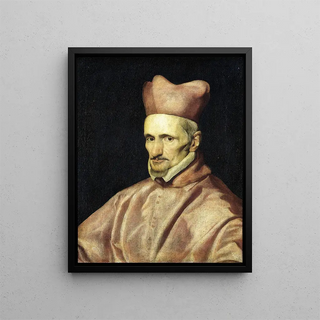Portrait of Cardinal Gaspar de Borja y Velasco - Diego Velázquez | Art print


View from behind

Frame (optional)
The "Art print of Cardinal Gaspar de Borja y Velasco" by Diego Velázquez is an iconic piece that transcends the simple framework of an artistic representation to become a true testament to the power of Baroque painting. Created in the 17th century, this work embodies not only Velázquez's undeniable talent but also his skill in capturing the very essence of his subjects. This portrait, depicting a man of faith and authority, offers a fascinating glimpse into the era and the values that governed it. As viewers contemplate this piece, they are invited to delve into the complex universe of the Spanish court, where art and politics intertwine inextricably.
Style and uniqueness of the work
The uniqueness of this portrait lies in Velázquez's technical mastery, which manages to render the texture of clothing and the depth of the gaze with remarkable precision. The color palette, dominated by warm and rich tones, gives the work an atmosphere that is both solemn and lively. The cardinal, dressed in sumptuous attire, is positioned at the center of the composition, emphasizing his high status. Delicate shadows and carefully placed lights create an ambiance of mystery and dignity. Velázquez does not merely paint a face; he captures the soul of the man, his thoughts, and aspirations. This portrait is a true window into the soul of the cardinal, revealing his spiritual concerns while affirming his ecclesiastical authority.
The artist and his influence
Diego Velázquez, considered one of the greatest masters in art history, knew how to leave his mark on his era through his innovative approach to painting. Trained in Seville, he quickly gained favor at the court of Philip IV, becoming the official painter of the Spanish monarchy. His style, characterized by meticulous attention to detail and a capacity to play with light, influenced many artists across centuries. Velázquez reinvented the portrait by incorporating a psychological dimension, going beyond mere physical representation. His work paved the way for generations of artists, from Rem

Matte finish

View from behind

Frame (optional)
The "Art print of Cardinal Gaspar de Borja y Velasco" by Diego Velázquez is an iconic piece that transcends the simple framework of an artistic representation to become a true testament to the power of Baroque painting. Created in the 17th century, this work embodies not only Velázquez's undeniable talent but also his skill in capturing the very essence of his subjects. This portrait, depicting a man of faith and authority, offers a fascinating glimpse into the era and the values that governed it. As viewers contemplate this piece, they are invited to delve into the complex universe of the Spanish court, where art and politics intertwine inextricably.
Style and uniqueness of the work
The uniqueness of this portrait lies in Velázquez's technical mastery, which manages to render the texture of clothing and the depth of the gaze with remarkable precision. The color palette, dominated by warm and rich tones, gives the work an atmosphere that is both solemn and lively. The cardinal, dressed in sumptuous attire, is positioned at the center of the composition, emphasizing his high status. Delicate shadows and carefully placed lights create an ambiance of mystery and dignity. Velázquez does not merely paint a face; he captures the soul of the man, his thoughts, and aspirations. This portrait is a true window into the soul of the cardinal, revealing his spiritual concerns while affirming his ecclesiastical authority.
The artist and his influence
Diego Velázquez, considered one of the greatest masters in art history, knew how to leave his mark on his era through his innovative approach to painting. Trained in Seville, he quickly gained favor at the court of Philip IV, becoming the official painter of the Spanish monarchy. His style, characterized by meticulous attention to detail and a capacity to play with light, influenced many artists across centuries. Velázquez reinvented the portrait by incorporating a psychological dimension, going beyond mere physical representation. His work paved the way for generations of artists, from Rem
12,34 €






